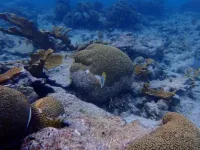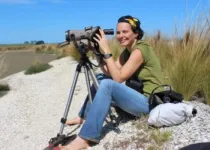(Press-News.org) The outbreak of a deadly disease called stony coral tissue loss disease is destroying susceptible species of coral in the Caribbean while helping other, “weedier” organisms thrive — at least for now — according to a new study published today in Science Advances.
Researchers say the drastic change in the region’s population of corals is sure to disrupt the delicate balance of the ecosystem and threaten marine biodiversity and coastal economies.
“Some fast-growing organisms, like algae, might thrive in the short term,” said the study’s lead author, Sara Swaminathan, an environmental engineering sciences Ph.D. candidate at the University of Florida. “But the loss of the susceptible corals could have long-lasting repercussions.”
Stony coral tissue loss disease, or SCTLD, was first reported off the coast of Miami in 2014 and has since moved throughout the Caribbean, having been identified in 18 countries and territories. Scientists don’t know what causes the disease, but it is thought to be a waterborne pathogen that spreads rapidly across the surface of the coral colony until, in most cases, no living tissue remains.
The research team analyzed existing data from the U.S. Virgin Islands as well as data from other U.S. territories in the Caribbean and western Atlantic, including Florida, Puerto Rico, and Dry Tortugas. They examined the effects of stony coral tissue loss disease on fish and benthic reef communities, which comprises anything living on the sea floor, like coral, algae, and sponges.
They found that the disease not only reduces susceptible coral populations but also diminishes crustose coralline algae, the resilient pink crust that is crucial for building reef structure. Consequently, certain fast-growing, weedy species, including macroalgae, cyanobacteria, and fire coral, thrive in the absence of competitors, spreading into the vacant spaces left by the decimated corals.
Swaminathan explained that fast-growing species benefitting from the disease create a more seaweed-dominated environment compared to the rock-hard reef structures.
“Macroalgae doesn’t support as much biodiversity because it doesn’t create a hard habitat,” she said. “It might be a positive for herbivores but not for other organisms that need places to settle and grow, hide, or mate.”
In fact, the researchers found that the disease’s impact varies among types of fish, and some associations are positive. The study revealed that the rugosity of the coral — the roughness of the habitat — plays more of a factor for the fish than whether the coral is alive or dead.
“Some infectious diseases can affect entire ecosystems, but SCTLD is particularly impactful,” said Kevin Lafferty, a senior scientist with the U.S. Geological Survey and leading expert on marine diseases. “And its impacts are complex, with some winners among the losers.”
In addition to Swaminathan and Lafferty, the research team included Andrew Altieri, an assistant professor in the Herbert Wertheim College of Engineering and associate director of UF’s Center for Coastal Solutions, and Nicole Knight, a post-doctoral researcher at the University of British Columbia. The work was funded by the U.S. Geological Survey and the National Science Foundation.
Across the Caribbean, international agencies, marine biologists and conservationists are responding to the environmental crisis, working to understand the mechanisms driving stony coral tissue loss disease and developing potential treatments. Probiotics have shown promise in slowing down or stopping active lesions when applied to affected corals, and so far, the disease has not spread beyond the western Atlantic and Caribbean.
“Coral reefs are biodiversity hotspots that serve as vital habitats for countless marine species, providing food, shelter, and breeding grounds,” Altieri said. “They are natural protectors of our coastlines, and the loss of these reefs threatens the livelihoods of coastal communities dependent on fishing and tourism. We need to protect and preserve them.”
-30-
END
Activated T cells that carry a certain marker protein on their surface are controlled by natural killer (NK) cells, another cell type of the immune system. In this way, the body presumably curbs destructive immune reactions. Researchers from the German Cancer Research Center (DKFZ) and the University Medical Center Mannheim (UMM) now discovered that NK cells can impair the effect of cancer therapies with immune checkpoint inhibitors (ICI) in this way. They could also be responsible for the rapid decline of therapeutic CAR-T cells. Interventions in this mechanism could ...
PHILADELPHIA — (May 3, 2024) — The Wistar Institute assistant professor Filippo Veglia, Ph.D., and team, have discovered a key mechanism of how glioblastoma — a serious and often fatal brain cancer — suppresses the immune system so that the tumor can grow unimpeded by the body’s defenses. The lab’s discovery was published in the paper, “Glucose-driven histone lactylation promotes the immunosuppressive activity of monocyte-derived macrophages in glioblastoma,” in the journal Immunity.
“Our study shows that the cellular mechanisms of cancer’s self-preservation, when sufficiently understood, can be used against the disease very effectively,” ...
Cambridge, Mass., – ADA Forsyth Institute (AFI) researchers received just under $10 million funding from the National Institute of Dental and Craniofacial Research (NIDCR) during the federal fiscal year 2023, placing 4th nationally on NIDCR’s ranking list.
“We have ranked in the top 5 dental institutions in 9 out of the past 10 years,” said Wenyuan Shi, PhD, Chief Executive Officer of AFI. “We have placed in the top 10 nationally every year since the ranking system began in 2002, despite having one of the smallest faculty ...
May 3, 2024—CHICAGO—The American Ornithological Society (AOS) is pleased to announce Judit K. Szabo, Ph.D., as the incoming editor-in-chief for its top-ranked journal, Ornithological Applications. Beginning on May 1, 2024, Szabo will work in partnership with the journal’s current editor-in-chief, Catherine Lindell, Ph.D., until June 30, 2024, and will take on full responsibility as editor-in-chief beginning on July 1, 2024. “With her international interest and network, conservation experience, and thoughtful approach ...
Long Beach, Calif. – May 3, 2024 – New data from the Acute Pulmonary Embolism Extraction Trial with the AlphaVac System (APEX-AX) demonstrated that catheter-directed mechanical thrombectomy is safe and effective in patients with acute intermediate-risk pulmonary embolism (PE) with significant improvement in the right ventricle (RV) function and minimal major adverse events. The safety and efficacy results from the prospective trial were presented today as late-breaking science at the Society for Cardiovascular Angiography & Interventions (SCAI) 2024 Scientific Sessions.
Pulmonary embolism (PE), a blood clot that blocks and stops ...
Long Beach, Calif. – May 3, 2024 – Late-breaking data from the ENGULF trial showed that a novel dual-action thrombectomy device was effective and safe in treating acute pulmonary embolism (PE). The safety and effectiveness results were presented today as late-breaking science at the Society for Cardiovascular Angiography & Interventions (SCAI) 2024 Scientific Sessions and simultaneously published in JSCAI.
PE is a serious cardiovascular event where a blood clot causes issues with blood flow and oxygen levels in the lungs. It can be ...
Long Beach, Calif. – May 3, 2024 – Recent findings from a study on a transcatheter heart valve (THV) system, which includes a new class of transcatheter aortic valve, showed positive results in the device's ability to function as a healthy and natural aortic valve in patients with aortic stenosis (AS). The late-breaking data will be presented today at the Society for Cardiovascular Angiography & Interventions (SCAI) 2024 Scientific Sessions.
AS is a thickening and narrowing of the aortic valve that can reduce blood flow to ...
Long Beach, Calif. – May 3, 2024 – Additional analysis from the SMall Annuli Randomized To Evolut or SAPIEN (SMART) study demonstrated clinical non-inferiority of self-expanding valves (SEV) versus balloon-expandable valves (BEV) in aortic stenosis patients undergoing transcatheter aortic valve replacement (TAVR) and confirmed valve performance superiority over time based on hemodynamics. Data also showed similar positive results in two age groups (< or ≥ 80 years old). The late-breaking results were presented today at the Society for Cardiovascular Angiography & Interventions ...
Study Title: Efficacy of [177Lu]Lu-PSMA-617 versus ARPI change in taxane-naive patients with metastatic castration-resistant prostate cancer by pre-randomization ARPI (PSMAfore)
Publication: American Urological Association Annual Meeting Plenary, May 3, 2024
Dana-Farber Cancer Institute author: Xiao X. Wei, MD
Summary: In a follow-on analysis of results from the phase 3 PSMAfore study, clinical investigators from Dana-Farber and elsewhere found that clinical outcomes consistently favored 177Lu-PSMA-617 over a change from one androgen receptor pathway inhibitor (ARPI) to another, regardless of which ARPI patients received first. ...
Late-Breaking Data Shows Endovascular Therapy Results in One-Third Reduction in Post-Procedural Complications for Women with PAD
Women and Asian Americans Less Likely to Undergo Endovascular Revascularization for PAD Compared to Men and Other Races
Long Beach, Calif. – May 3, 2024 – New clinical results highlight the need for inclusive approaches and comprehensive examinations of treatment options for peripheral artery disease (PAD), including endovascular therapy and revascularization. The data ...











